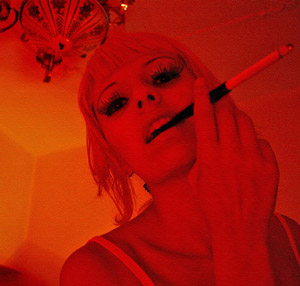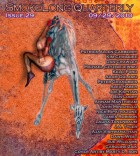Some of my favorite stories are about what I would call “queer heterosexuality,” by which I mean characters who ostensibly are “heterosexual” as that has been defined in our current culture, but whose identities or desires somehow complicate what we think of as “normal” sexuality and gender, that show that “normal” is really more of an ideological construct that reinforces dominant power than it is any kind of statistical reality. I read your bearded lady as “queer,” in a way, because of how she has been cast as freak and also because of her desire for a tentacled man. I feel like maybe the experiences of so-called circus freaks have always resonated in a way with those of queer folks. Can you tell me more about what drew you to circus freaks as a subject, and to the bearded lady in particular? What made circus freaks compelling for you? Do you object to my “queering” of your character?
I love the term “queer” and its application to just about everything, so I certainly wouldn’t object to its use here. In specific reference to this character, your reading of her is absolutely on point, although I locate her queerness in one very specific aspect of her gender identity—her acceptance of the beard. Everything else, her sexuality and all other aspects of her gender identity strictly adhere to that of a boring straight woman, as you write a “normal” woman, a statistical reality. The pink room, the EZ Bake Oven, the (non-explicit) yearning for all of the stereotypically and borderline offensive female goals: family, laundry, gardening, gossiping with other homemakers, etc—her gender identity is clearly “woman,” clearly “normal.” Similarly, she has sex with men and constructs a strict (fictional) heteronormative relationship in which her husband, Husband, handles the family’s finances, makes the important decisions regarding their retirement plans and convinces her to leave the clutches of her coolly distant employer (and maybe father). “Normal.”
This character is interesting, at least to me, because she accepts her facial hair—that’s what makes her queer. Not the facial hair itself, mind you. Her acceptance of it, her willingness to let it grow denotes her as outside the construct of “woman.” Women grow facial hair. Biological women can grow more facial hair than some biological men, men in my family are intimately familiar with this occurrence. If you watch any broadcast television, I would wager you’ve seen those commercials depicting women shaving off mustaches with miniature buzzers, or rubbing sideburns off with a textured pad, or bleaching chin hairs. The prevalence of women’s facial hair has never been more benign and yet the thought of a woman not “fixing” this hair, of walking around with a soul patch or what-have-you is almost unheard of. So this is what I wanted to write about more than “circus freaks,” per se. I don’t really see her as a “freak” even though the nomenclature “bearded lady” points in that direction. I was drawn to write about a woman’s relationship with her facial hair. She is just a woman who happens to have a beard, happens to want that beard. The circus seemed like a nice home for her—although now that I am really examining it, it may have been far more scandalous to attend block parties and PTA meetings.
One line that I struggled with was “She will be what she is meant to be, and if that means old, if that means not in this tent or on this train—” I wanted that line to also be her affirmation of why she keeps the beard, but am not sure that comes across. I almost included “and if that means with a beard…” but thought that too upfront. Growing body hair is a part of being a biological woman: eyebrow, armpit, leg, belly, arm, even facial. The removal of that hair is what marks a woman’s compliance with the gender role of “woman.” This character wants to be what she was meant to be, wants to be a painfully “normal” woman on every level except cosmetological intervention, hair removal—and if that makes her queer, she’ll accept that.
I am quite interested in flash fiction’s use of time. One thing you see a lot in flash fiction is the exploration of one particularly weighty moment. Another is the coverage of much larger stretches of time within a matter of sentences. This piece strikes me as being more like the latter — you present us with much of this woman’s life and current condition within a compressed space. Can you talk more about how you approached this piece structurally? Were there any existing models you drew upon? Did it emerge organically? Did you construct it really deliberately? Etc.
That freedom to play with time is one of my favorite aspects of writing short fiction. In one sentence we can write about the minute twitch in a character’s nose hair and then very next sentence can say “Ten years later, after the man’s wife passed, after his neighborhood changed and yuppies moved in on either side of him, after his double mastectomy—he finally read Tolstoy.”
I wish I had the ability to better prescribe the structure of a story before writing it. That probably makes the writing process far less stressful. So no, I didn’t really have a set structure going into it—rather I had the images and characters. In fact, I struggled a bit while writing “Bearded” because everything that came out read as exposition, character description, a succession of events without purpose or connectivity. However as I continued, pieces fell a bit more into focus and eventually settled together in a way that, hopefully, constructs a complete narrative.
A few months ago I heard Aleksandar Hemon describe his writing process. I am paraphrasing (and potentially bastardizing); he said that the most important part of his process is not writing and that in those times of not writing he allows the really important stories a chance to build urgency. Eventually, they need to be written, and he writes them. If he forgets a story, it’s probably because the story wasn’t very good in the first place. That’s how I feel about my own work, “Bearded” in particular. I had all these pieces and when I needed to write them, they fell together and the conflict and narrative came out of that.
I think one of the things that really powers this piece is its sentences, and in particular, your use of repetition. For me, really rhythmic, repeated phrases like the negations of the first paragraph, or the repetition of “lives” in the second, produce a physical affect, make the piece almost like music… the Ballad of the Bearded Lady? Can you talk about what inspired your sentences, and some of the “tricks” you used?
I read everything I write aloud as I write it. Even now, even in public—I mumble to myself like a lunatic or a victim of that mad cow disease. That’s my biggest trick—reading my own work over and over, reading it aloud. So for me for me, writing is a very physical process, and I’m glad to hear that it came out that way on your end. If I am writing about an incensed character, I wind up physically behaving incensed, pounding the keyboard, pacing, rolling my eyes and shaking my head as I read. I like to think that this provides more emotional authenticity to the text—but maybe it just makes me look more like a lunatic.
In terms of repetition, I am always cognizant of the fact that it can very easily turn into abuse. Repetition without expansion is pointless. If I repeat a phrase or a sentence, the purpose is to cover a descriptive nook that was previously untouched. Take for example a sentence I repeat three times in “Bearded,” “She is a woman.” My intent is to provide a new understanding of the character’s gender identity through each incarnation of the sentence: how her gender constructed for her as a child, how she constructs her sexuality and how she establishes independence. She is a woman—that means many things. I wanted to write about that multitude.
This piece has a lot of really powerful images, like the EZ Bake Oven, the fruits, all the viscera of circus life. Where do you find most of your images?
I love the image of a lumbering homunculus with giraffe legs and sweeping tentacle arms wearing a business suit and having a serious conversation about one’s financial portfolio—with a straight face saying things like “I really don’t see the potential for growth in an annuity. You should really look to re-invest in the market. We’ve found the bottom.” I spent far too long thinking about the actual mechanics of it, how paper would stick slightly to his tentacles and he would absentmindedly shake it off without altering the seriousness of the interchange. This is all to say I get obsessed with strange and overly specific images. To compensate, I try to be conscious of balancing the hyper-real images with stock, easily accessible ones. For example, the lion tamer: when picturing the circus, I can’t think of a more stock image than the lion tamer posed with chair in one hand, whip in the other, bracing against of a rearing lion. That image isn’t a stretch for anyone to imagine—so I offer that stock image in concert with the absurd ones. As for where they come from, I commute an hour and a half to work and an hour and a half home from work five days a week—I have a lot of time to dwell, to think of words that start with P.
The thing that cemented my love for this story was your last sentence, which totally kills — I feel like it somehow perfectly captures this woman’s loneliness, but without being too resolved or conclusive or obvious or heavy-handed. I recently saw Kyle Minor say somewhere that you can get away with pretty much anything you want in very short fiction so long as you’ve got the right last sentence. I am very jealous of people who are able to conjure killer last lines, because I think it is one of the things I’m weakest at in my own work. Can you talk about where yours came from?
Like I said earlier—when I sat down to write this piece, I wasn’t entirely sure where it was going to go. And when it came time reintroduce the father, I didn’t want to make anything absolutely concrete. So it certainly isn’t just you, the endings to stories are the hardest. We need to simultaneously avoid the twist “He’s been dead for ten years” ending as well as avoid anything overly blatant and boring. I wanted to leave the reader with a sense of this woman’s life, one filled with constant reiterations of her solitude and questions of her womanhood. I am now paranoid that that isn’t a good enough last line to the interview. Oh, well.



 The core workshop of SmokeLong Fitness is all in writing, so you can take part from anywhere at anytime. We are excited about creating a supportive, consistent and structured environment for flash writers to work on their craft in a community. We are thrilled and proud to say that our workshop participants have won, placed, or been listed in every major flash competition. Community works.
The core workshop of SmokeLong Fitness is all in writing, so you can take part from anywhere at anytime. We are excited about creating a supportive, consistent and structured environment for flash writers to work on their craft in a community. We are thrilled and proud to say that our workshop participants have won, placed, or been listed in every major flash competition. Community works.